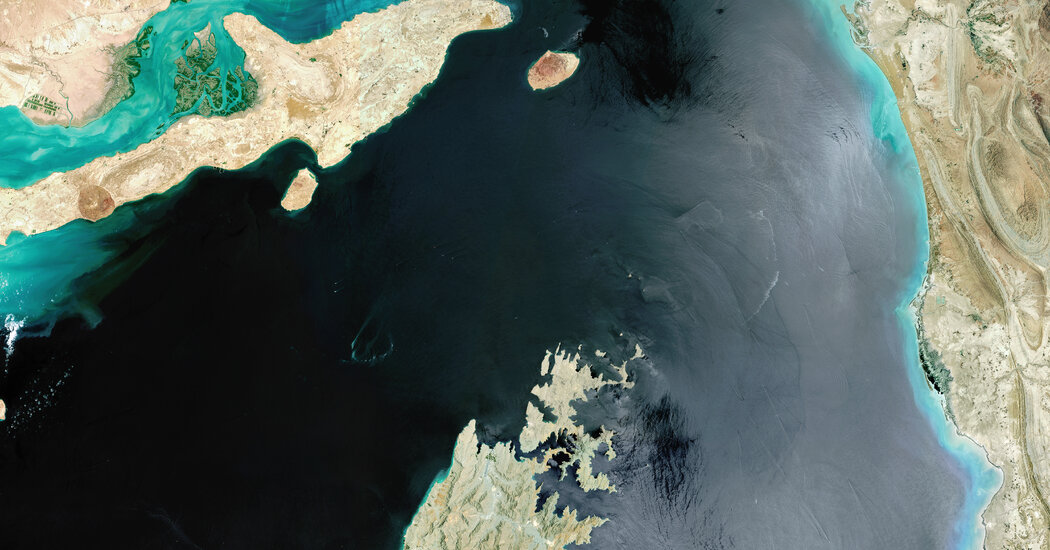One way that Iran could potentially retaliate for the American strikes on three of its nuclear sites, analysts say, would be to shut down the Strait of Hormuz, a key shipping route for oil and gas.
In meetings at the White House, senior military officials have raised the need to prepare for that possibility, after Iranian officials threatened to mine the strait, a narrow 90-mile waterway connecting the Persian Gulf to the open ocean. Such a move could pin any U.S. Navy ships in the Persian Gulf, American military officials say.
In more than a week of fighting between Israel and Iran, Israel’s military has steered clear of hitting Iranian naval assets. So while Iran’s ability to respond to attacks has been severely damaged, it has a robust navy and maintains operatives across the region, where the United States has more than 40,000 troops. Iran also has an array of mines that its navy could lay in the Strait of Hormuz, which hugs a portion of Iran’s southern border.
A quarter of the world’s oil and 20 percent of the world’s liquefied natural gas passes through the Strait of Hormuz, so mining the choke point would cause oil and gas prices to soar. The majority of those fuels go to Asia, meaning that countries there would most likely be severely affected by any closure. The United States and other countries would feel the effects in the form of higher energy costs.
Closing the waterway could isolate American minesweepers in the Persian Gulf on one side of the strait. Two defense officials indicated that the Navy was looking to disperse its ships in the gulf so that they would be less vulnerable. A Navy official declined to comment, citing operational security. The officials spoke on condition of anonymity because they were not authorized to speak publicly.
Even before the U.S. military struck Iranian nuclear sites over the weekend, Iran vowed that it would respond forcefully to any attack by American forces — potentially setting off a cycle of escalation. Since the strikes, Iran appears to be weighing its options.
“Iran is strategically weaker but operationally still lethal across the region, and Americans still have troops across that part of the world,” said Brian Katulis, a senior fellow at the Middle East Institute.
Military officials and analysts said missile and drone attacks remained the biggest retaliatory threat to U.S. bases and facilities in the region. Some also worry that the Quds Force, a shadowy arm of Iran’s military, could attack U.S. troops.
Much is at stake for Iran if it decides to retaliate. “Many of Iran’s options are the strategic equivalent of a suicide bombing,” said Karim Sadjadpour, an Iran policy expert at the Carnegie Endowment for International Peace. “They can do enormous damage to others if they mine the Strait of Hormuz, destroy regional oil facilities and rain a missile barrage against Israel, but they may not survive the blowback.”
But Iran can make it hugely expensive, and dangerous, for the U.S. Navy to have to conduct what would most likely be a weekslong mine-clearing operation in the Strait of Hormuz, according to one former naval officer who was stationed on a minesweeper in the Persian Gulf. He and other Navy officers said that clearing the strait could also put American sailors directly in harm’s way.
Mining the strait would also inflict severe economic damage in Iran because nearly all of the country’s oil exports move through the channel.
Helene Cooper is a Pentagon correspondent for The Times. She was previously an editor, diplomatic correspondent and White House correspondent.
Eric Schmitt is a national security correspondent for The Times. He has reported on U.S. military affairs and counterterrorism for more than three decades.
John Ismay is a reporter covering the Pentagon for The Times. He served as an explosive ordnance disposal officer in the U.S. Navy.
The post What Is the Strait of Hormuz, and Why Is It Important? appeared first on New York Times.



